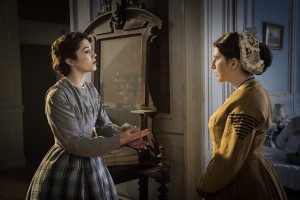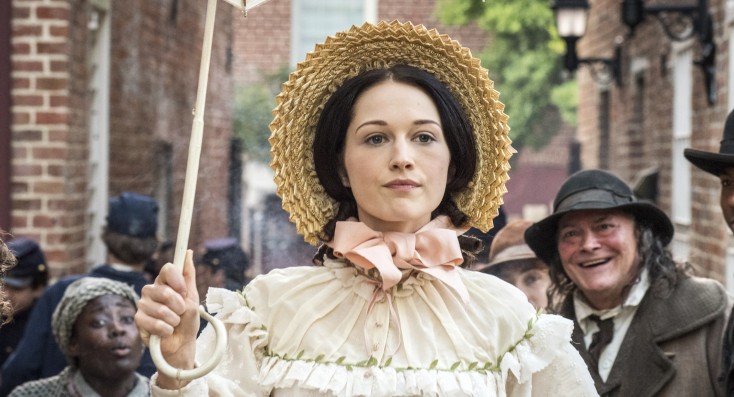
(l-r) Nurse Mary Phinney (Mary Elizabeth Winstead) and Nurse Anne Hastings (Tara Summers) in MERCY STREET. ©PBS. CR: Antony Platt.
By ANGELA DAWSON and JUDY SLOANE
Front Row Features
HOLLYWOOD—“Mercy Street,” which debuted on PBS in mid-January, is the public television entity’s first original American‑based drama in more than a decade. Set in a Northern Virginia hotel converted into Union military hospital during the Civil War, the six-episode season captures the horrors and heroes of the period.
PBS executives hope to make “Mercy Street” a multi-season series should it prove a hit with viewers. It is executive‑produced by Lisa Wolfinger, David Zabel, and David Zucker, as well as well as four-time Academy Award nominated director Ridley Scott (“The Martian,” “Gladiator”).
Bolstering its odds for success, the series follows PBS favorite “Downton Abbey” airing on Sunday nights. Reminiscent of both Cinemax’s “The Knick” for its graphic depiction of surgery and amputation and “Downton” for its fast-paced, multi-storyline period plot, “Mercy Street” depicts a long ago world where people of different races, classes, and political and social values collide. It also mixes in some humor as a buffer against the horrors of war, as well as romance and passion for good measure. Filming was completed last summer downstate from its Alexandria, Va., setting in Richmond and Petersburg.
The producers cast from New York and Los Angeles, as well as locally in Virginia. One of leads, newcomer Hannah James, hails from Madison County, Virginia, near where filming took place.
James plays Emma Green, a beautiful, dark-eyed Southern belle, who volunteers at the Union-occupied Mansion House hospital (previously a hotel owned by her family prior to the war) to help care for its underserved Rebel soldier patients. She soon realizes that wearing her Sunday best—a white gown worthy of pre-war Scarlett O’Hara—isn’t suitable attire for the bloody heap of blood and guts she finds in the bustling hospital’s prisoner ward.
James, along with co-stars AnnaSophia Robb, who plays Alice Green, her naive younger sister, and Mary Elizabeth Winstead, who plays Mary Phinney, the newly appointed head nurse, a widowed New England abolitionist who joins the hospital’s staff in the pilot episode and henceforth has to contend with sexist doctors and an overworked nursing staff on the edge of rebellion, spoke about the series during the Television Critics Association tour.
Q: Was that mix between British and Southern dialect a dead dialect? Is that something you had to reproduce, or is that still being spoken somewhere?
James: No, I don’t think it’s being spoken like that. I’m from Virginia, and I’ve never heard someone speak like that. But I was trained (as an actress) in England, so my accent is a bit transatlantic accent anyway. I guess I sort of heightened my own accent and then threw in the Southern lilt. I guess we were sort of going for Scarlett O’Hara, sort of “Gone with the Wind,” accent. But we also sort of did our own version, and as we worked together. We sort of melded it into our Green family accent.
Q: Since you were born and raised near where the series was shot, were you able to invite everybody and bring them to your farm?
James: Yeah, to my little farm. I lived about an hour and a half off set in my childhood farmhouse, so we had a little group of us go and play on the weekends, which was great. If we go to Season 2, we’ll be gallivanting in the Virginia countryside.
Q: When you were filming “Mercy Street” last year, were a lot of those structures already there, or did you have to build very much? How did you decide on a particular accent?
James: It’s funny. The Southern accent or the sort of Southern accent that we did, which is the non‑rhotic, is very much a mix between a British accent and a Southern accent. So there were a lot of difficulties, especially with me doing ADR (recording in post-production), where I sound British in a little bit of a section and Southern in a section. But they are so similar that they sort of go hand in hand, which was difficult to remain in that sort of Southern lilt. That is really where it is, is the tune of the accent that makes a difference. We had an accent coach that worked with us, but we sort of just played with it. And once you get into the rhythm of it, you sort of fly with it. We had a good time with it.
Robb: We definitely did. And spending some time with the Green family and, Donna Murphy (who plays their mother, Jane Green) but we would all sit around and just kind of hear each other’s accents and figure it out. Donna’s character, we thought, would be from South Carolina. So we based the accent on that and then just got into the flow. It just sort of became part of the character, like the dresses.
Winstead: Right. It was really kind of fine‑tuning because we didn’t want to go over the top. For Mary, we kind of wanted her to be believably a New Englander, but not so much that it kind of takes you out, because, especially for the first episode, she’s kind of the audience. She’s showing the audience this hospital and kind of the person. You’re seeing everything through her eyes, so we wanted her to be a little bit more (voice) neutral, but still believable. So it was really going just through the specific vowels and specific words that could be clipped or could be a little bit more curt and polished than the way that I normally speak. I was trying to up my game a little bit in the diction world.
Q: Can you discuss finding the right tone for this, because obviously you’re not going to go as far as “The Knick,” in terms of bloodiness, but you also want to be authentic and historically accurate for PBS?
Robb: All of us actors were handed a huge binder of resource materials—books to read, films to watch and histories to read. We had many experts on the set, medical experts, and also behavioral experts. (Historian) Anya Jabour came on set and would advise us on how to behave, how to walk. We would consult with the costuming (department). Every time Hannah and I had to exit a house, we’d have to wear gloves, hats and a coat, as was proper for ladies of the day. My character is very much growing up, so she’s in the midst of going from school, to becoming a young woman. The Civil War provided this interesting moment for women of the South to assert themselves, because they could have a purpose, fight for a cause, instead of taking a backseat (to the men), because the men were off to war. So it puts Alice in a very vulnerable position, where she has a lot thrust upon her at this (young) age. She and Emma’s character have some big decisions to make.
Q: All of the main characters are either directly based on real people, like Mary’s character, who wrote a memoir about her time at the hospital. Mary, did you read her memoir and was it helpful to you in creating your character?
Winstead: Sure, and it was incredibly helpful. I was sort of cast somewhat last minute, and flew in and got started right away, and kind of dived into her memoir. I was shooting this at the same time as I was discovering things about her. I sort of gave everything over to the (writers and producers), who were creating such an authentic environment. I really felt like I was experiencing what she was experiencing when she first came to this hospital and met all these people. All of it is in her text as I’m acting it from day to day. It was kind of a wonderful, special thing to be a part of and to bring to life.
I also felt I related to her so much and felt that her ideals and her views and what she was trying to accomplish and the way that she behaved was so contemporary and so much like myself and people that I surround myself in my life. I very much saw her as a friend as I was reading this and performing as her. So it was a wonderful and special thing to get to do.





